
Last Update - 18 April 2014

Last Update - 18 April 2014
Please select year from Menu |
1929 Event
A wet day
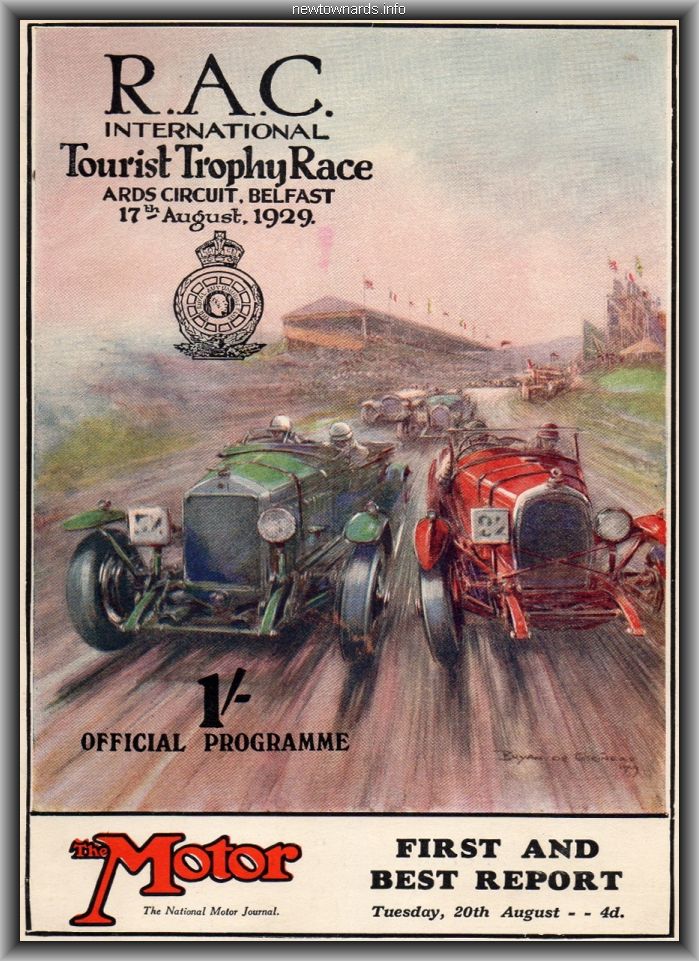
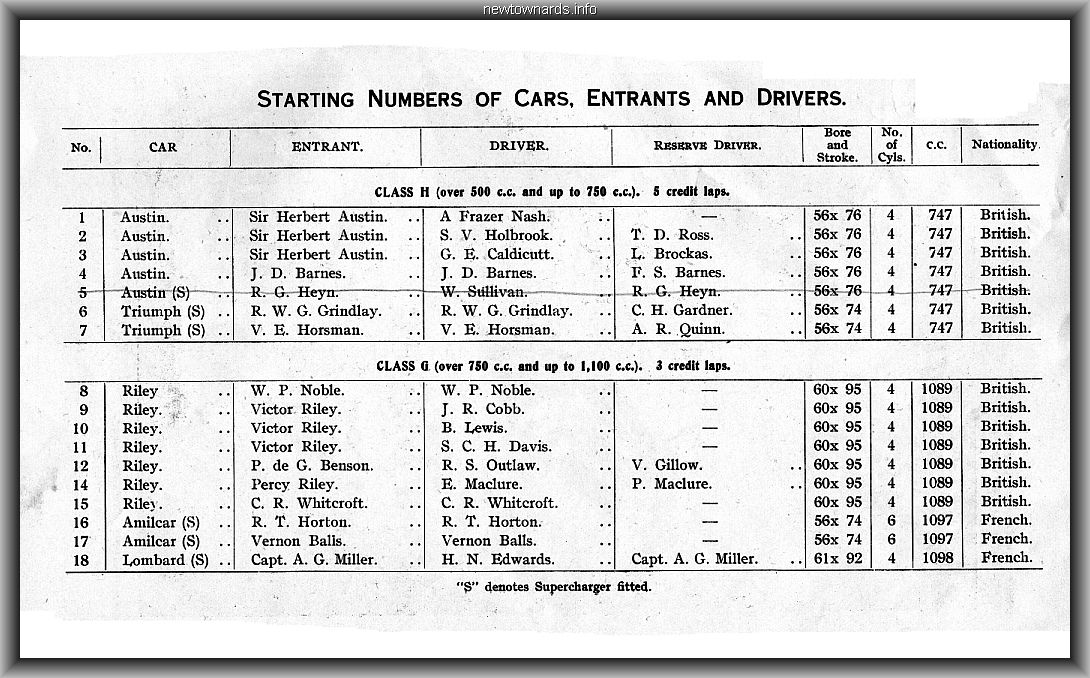
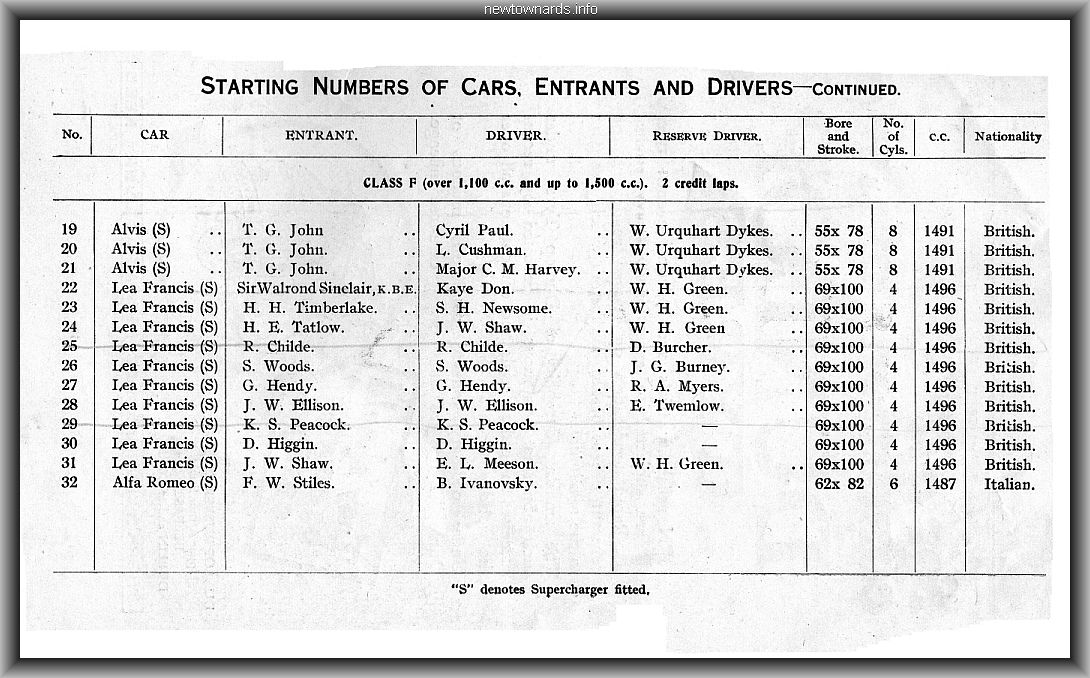
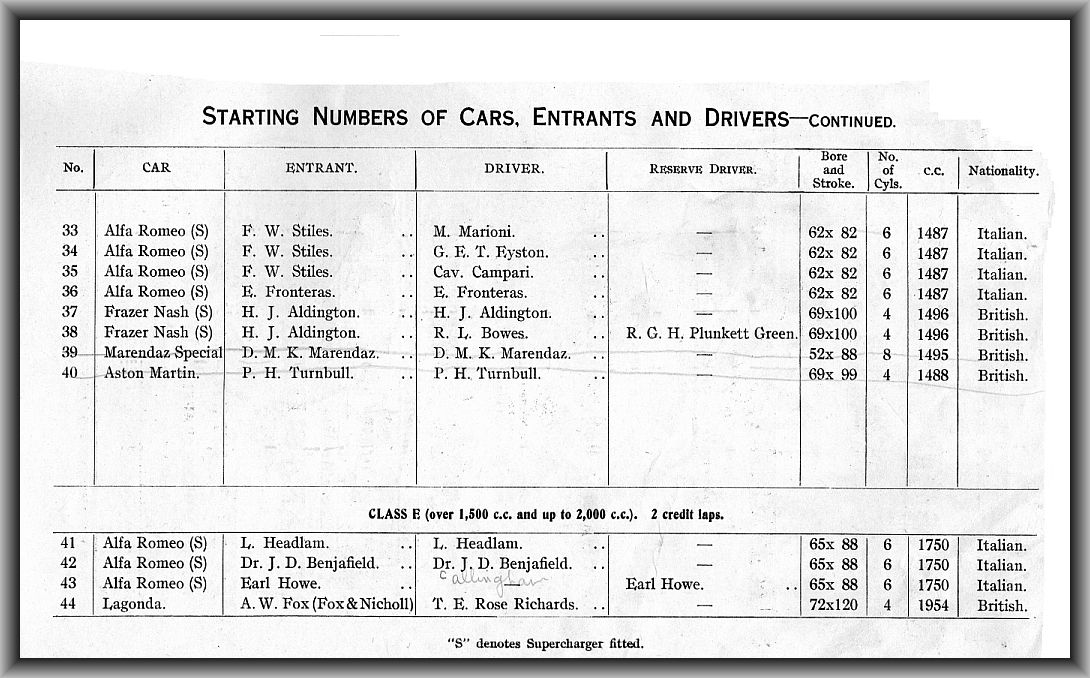
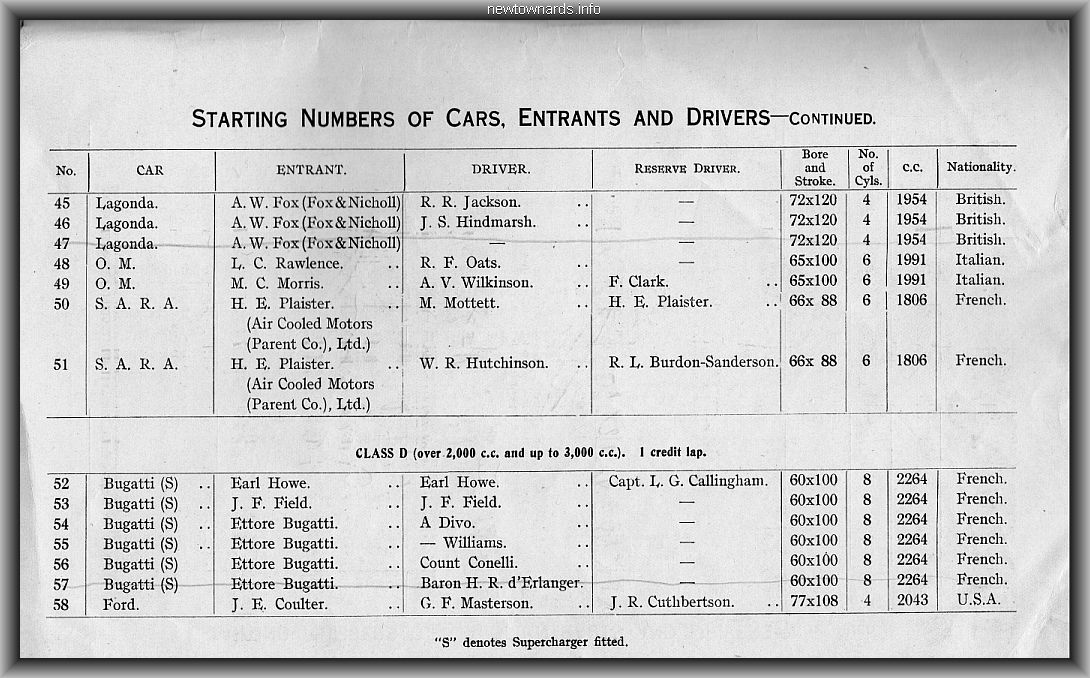
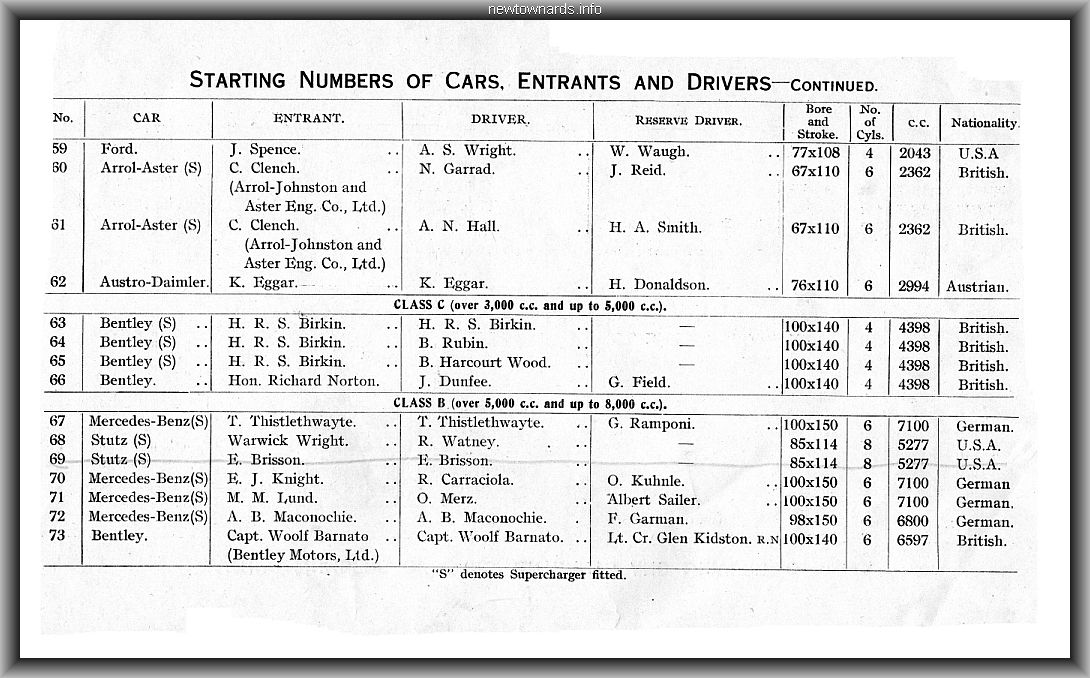
Glasgow Herald 16th. August 1929
German driver laps at 75 m.p.h. - Merz in a
Mercedez set a new lap record for the Ards course in 2nd. official practice yesterday for
the R.A.C. T.T. race tomorrow.
Merz time was 10 mins. 55 secs. his average speed on a course abounding with sharp bends,
tortuous curves and bumpy crossings and other hazards being 75.12 m.p.h.
At one part of the course he was going at approx. 120 m.p.h.
Cheek of a Seven
Merz's record lap and other fast times recorded yesterday indicate that tomorrows race
will be run at higher speeds than last year, for most of the drivers yesterday seemed to
have something in hand. Nearly all the drivers and reserve drivers have qualified but no
official declaration on this point has been issued.
Among the incidents of the day may be mentioned the audacity of a "Baby" Austin
which created a sensation in Newtownards Conway Square by actually passing a big Mercedes.
Needless to say it received a resounding cheer.
Big car on fire
A Bentley driven by Hayes went on fire just past quarry corner but driver and mechanis
succeeded in extinguishing the flames before the firefighting staff reaced the incident.
Another Bentley while stopped in the pits also appeared to catch fire momentarily.
The Square in Newtownards was again the scene of exciting cornering and several cars
approached so fast that they were forced to run up the slip road and turn before taking
the corner. Among the fastest at this point were Kaye Don in his Lea Francis, Major Harvey
in his Alvis, Campari in the Alfa Romeo and Merz in the Mercedes.
Caldicott was the fastest of the Austin entry lapping at 13 mins. 19 secs. Triumphs were
slow .. Horsmans best being well over 14 mins. Lewis was the fastest Riley driver with 12
mins. 27 secs. Vernon Balls in the Amilcar did no better then 13 mins. 34 secs. Harvey in
the Alvis was easily the fastest of this team lapping in 11 mins. 50 secs. but these cars
are reported to have not been extended unduly.
Kaye Don and Campari were fastest in their class both lapping in 11 mins. 44 secs. a speed
which suggested that either had a good chance of winning on handicap.
The 2 litre Alfa Romeos were slower in comparison with their smaller brothers and the
Lagondas were not exciting,. Divo the crack Bugatti driver lapped in 11 mins. 15
sexc. only 1 sec. slower than Thistlethywates best,. Carraciola in the
Mercedes lapped in 11 mins. 3 secs. and Birkin was best of the Beltleys in 11 mins. 14
secs.
Inanovsky - v - Ramponi
A thrilling duel is looked for on Saturday when Ivanovsky the Russian winner of the Double
Irish Grand Prix and Ramponi the Italian crack, both will be driving in Alfa Romeos.
In the Irish G.P. they both fought like mad things for 30 laps before Ramponi dashing
around corners at impossible speeds skidded and broke a rear wheel. The Russian went on to
win the race
After that Ramponi left Alfa and agreed to drive with T.Thistlethywate in the bif Merdedes
Benz. Yesterday however Ramponi was offered Mr.E.Frontera's Alfa and immediately agreed
...
The car is not one of the official team , two Italian drivers have M.Marioni and Cav.
Campari having come from Italy to lead the entry. In addition to these Dr.J.D.Benjafield,
G.E.T.Eyston and L.Headlam will be driving the Italian cars so that on paper the Alfas
have the best chance of winning.
The fame of Divo who is considered to be the greatest road racing driver the continet has
produced , has spread, although the intrepid driver has never been seen in Ireland before
.. and the #54 painted in white on his Bugatti is looked for by everyone.
Alfa Romeo Hitch
A sensation was caused when a rumour spread around tonight that the Alfa Romeo team had
failed to satisfy scrutineers in the compliances with the regulations. The rumour was well
founded but after careful examination of the cars and consultation with with the stewards
of the meeting it was decided to pass the cars. Had this not been done there must have
been considerable dissappointment amounting almost to resentment in both the motoring and
public circles owing to the fame surrounding them.
S.A.R.A. 1929 Newspaper Article
At a luncheon given recently by Air-cooled Motors
(Parent Company), Ltd., Sir Alfred Mays-Smith (in the chair) called attention to the scope
for air-cooled engines in countries where extremes of climate make watercooled engines
troublesome. He mentioned their importance for military transport (especially in vehicles
such as tanks and artillery tractors that are subjeet to shell and rifle fire), and for
general utility purposes where the weight and complication of watercooling imposes
handicaps.
He remarked that the development of a thoroughly reliable air-cooled engine was a matter
of some importance and that Great Britain has obtained a commanding lead in this rich
field. He was referring to the fact that a British syndicate has secured the world's
rights for the manufacture and sale of S.A.R.A. air-cooled engines. These have acquitted
themselves. with distinction in the Le Mans 24-hour Race for six successive years. It is
understood that the flotation of a new company to exploit the S.A,R.A. engine is impending
and that models suitable for coach and lorry purposes are already in existence.
S.A.R.A. 21st. September 1922 Engineering Journal Article
AIR-COOLING has never found much favor among the automobile manufacturers of Ckjntinental Europe. Even the prominence given to 67 cu. in. light two-seater cars, during the last three or four years, has failed to bring forth anything but four cylinder water cooled jobs. The first break away from this preference for water cooled power plants has been made by a French company formed to produce the S.A.R.A. light car with a four cylinder air cooled engine to the designs and patents of engineers Tiserant and Piazzoli. Incidentally this is the only four cylinder air-cooled job in France and also the only one with a forced draught of air. The S.A.R.A. has four separately cast cylinders of (52 by 91 mm. with vertically placed cooling fins and vertical valves in the head, operated in the usual manner by push rods and overhead rockers. The four cylinders, which are mounted on an aluminum basechamber, are surrounded by a cast aluminum air jacket with which is combined a centrifugal turbine in the forward portion, immediately behind the dummy radiator. The turbine is driven from the crankshaft at one and a half times engine speed by a broad woven camel's hair belt. Eccentrically mounted ball bearings are used for the turbine shaft, thus allowing of taking up slack in the belt.
The turbine is capable of handling 56,000 cu. ft. of air a minute. It draws the air into a spiral housing and delivers it through the two main air leads forming a V when seen in plan view, to left and right of the cylinder heads. The portion of the air jacket immediately above the cylinder heads is removable for access to the valves, and on its inner face is a baffle which serves to deflect the horizontal current of air downward, around the cylinder barrels. The shape of the air passages has been designed to reduce resistance and the interior is finished off perfectly smooth, with a view to securing efliciency and silent operation. Official tests of this engine have been made at the laboratory of the Automobile Club of France, under the direction of Engineer Lumet. Of .si.x individual one-hour full load tests, the average power developed was 28.9.3, at an average crankshaft speed of 2668 r.p.m.. The maximum engine speed was 2720, and the lowest speed to which the engine could be throttled was 210 r.p.m. These trials were made with an American Bosch magneto and Solex carbureter. There was no misfiring at any time, the cooling was satisfactory, and the engine was free from vibration. The engineers responsible for the S.A.R.A. point out that being stationary instead of in motion through the air, the turbine absorbed more power than would have been the case had the engine been moving over the road at the corresponding car speed. The difference probably would have brought the power up to 30.
As the cooling is designed to be adequate for the
most strenuous conditions, the engine will run too cold on average service. On this
account a throttle is fitted in the
mouth of each of the two main air passages and a single control brought up to the diish. A
distance type thermometer is also fitted at the base of the air jacket, between
cylinders No. 2 and .3, with its dial mounted on the dash by the side of the throttle. The
most advantageous degree of heat is marked on the dial, and clients are
recommended to adhere to this, by the use of the air throttle.
A TWO ball bearing crankshaft is used for the engine. The connecting rods are I-section
and of bronze-aluminum alloy. Pistons are of aluminum alloy. Lubrication is
assured by a gear pump which delivers oil direct to the crankshaft bearings and to troughs
for the connecting rods. The intake manifold arrangement is one which is
finding increased favor among Continental engineers. A perfectly straight manifold, of
uniform section, poli.shed internally, is employed. A Solex carbureter is mounted
at the dashboard end by means of a flange. A hole is cut in the dash .so that the driver
can reach the carbureter without moving from his seat. This type of mounting is
used, among others, on the V'oisin 12-cylinder engine.
The weight of the engine, including its accessories,
is 175 lb. The chassis has a wheelbase of 99 in., a track of 43 in., and weighs, complete,
640 lb. The S.A.R.A. has
a three speed gearbox forming a unit with the engine, an inclosed propeller shaft and
Gleaaon gears, without a diff'erential, in the rear axle. Springing is transverse in
front and quarter elliptic at the rear. The latter, as will be noted by reference to the
cuts, are bolted inside the channel section side members of the frame, and radius
rods are fitted above the spring. The radius rods are hinged to the frame at the points at
which the rear springs are attached.
NOTE: These engines were also used in Aircraft
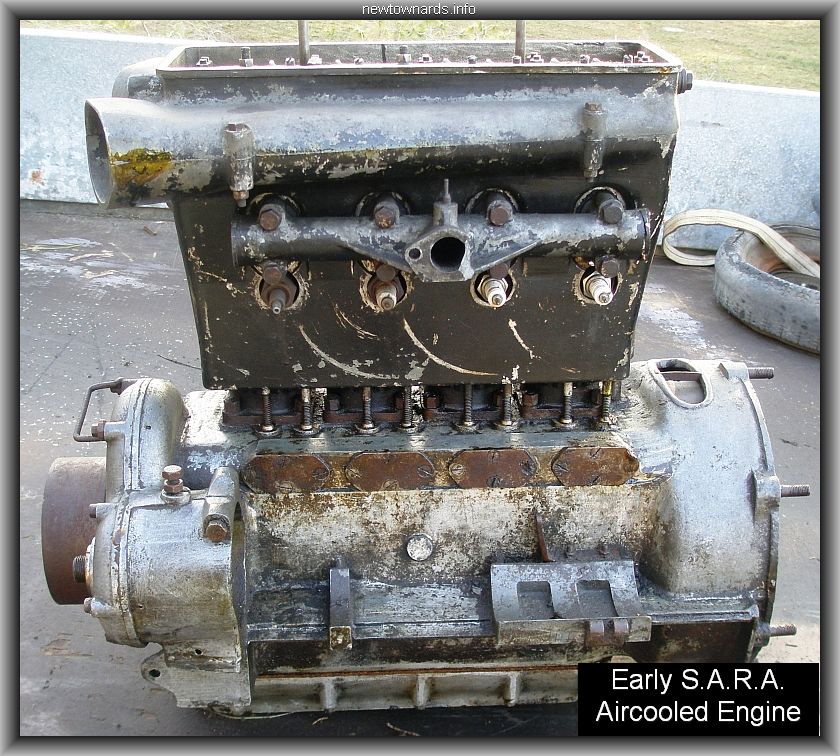
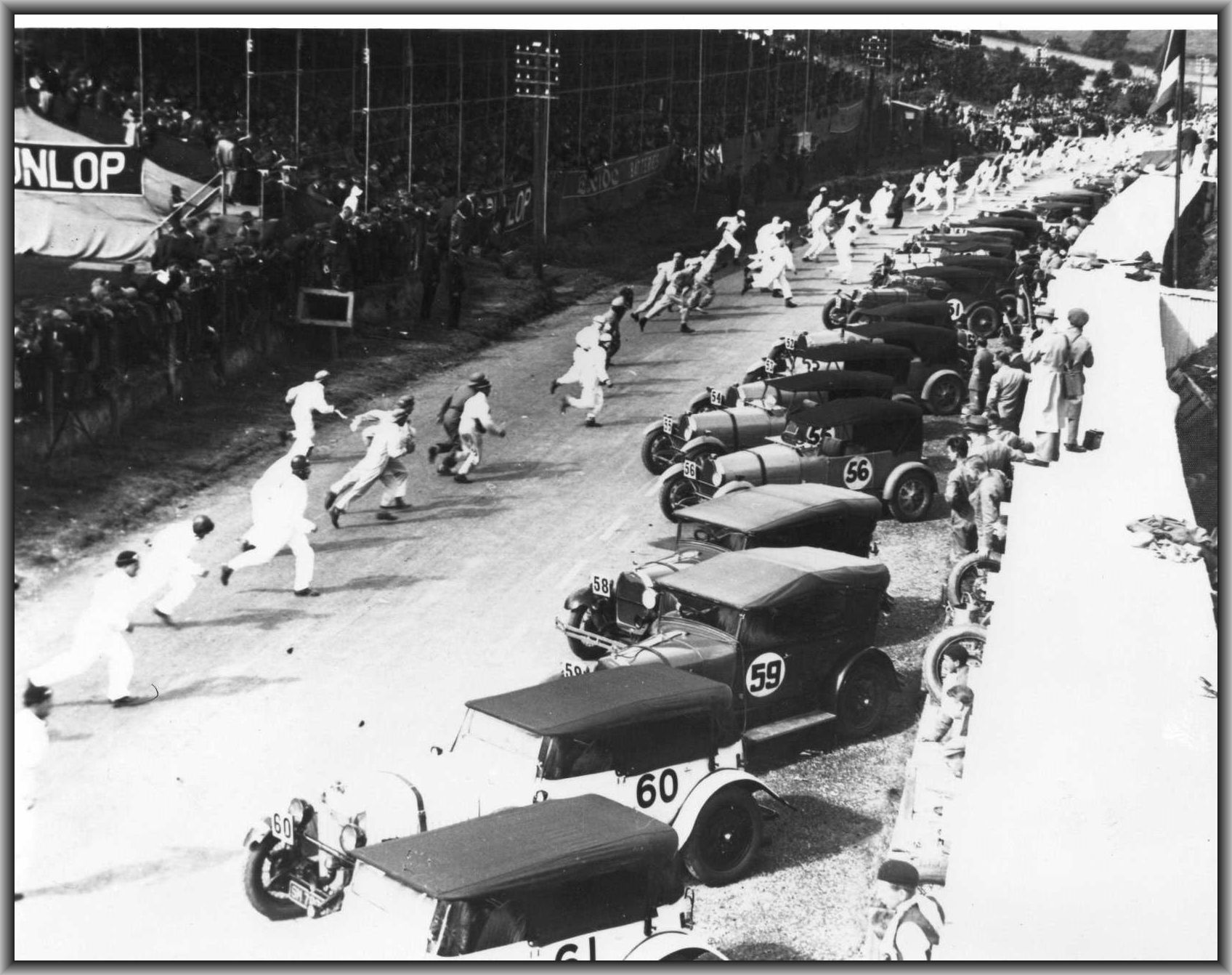
The old blurry image has been replaced by this one courtesy of Michael McDowell,. of the
start of the 1929 race..
Excellent quality
You can see that the cars are in their numbered positions and 57 is missing,. Tim
Birkins 63 is just out of shot..
Note - One pic has roofs up and the
other roofs down ...
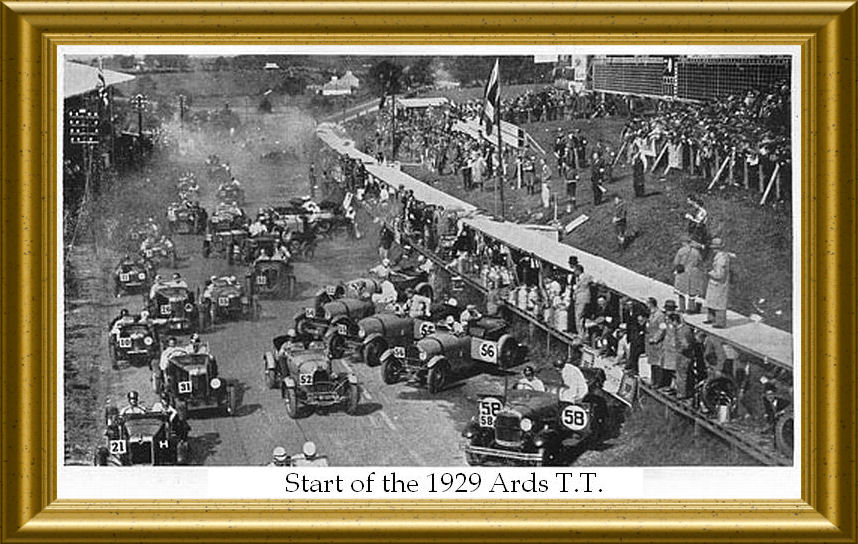
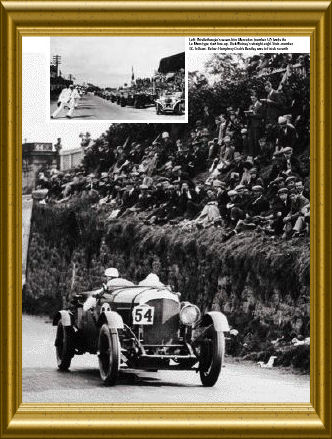
Humphrey Cook racing to 7th. place in his Bentley
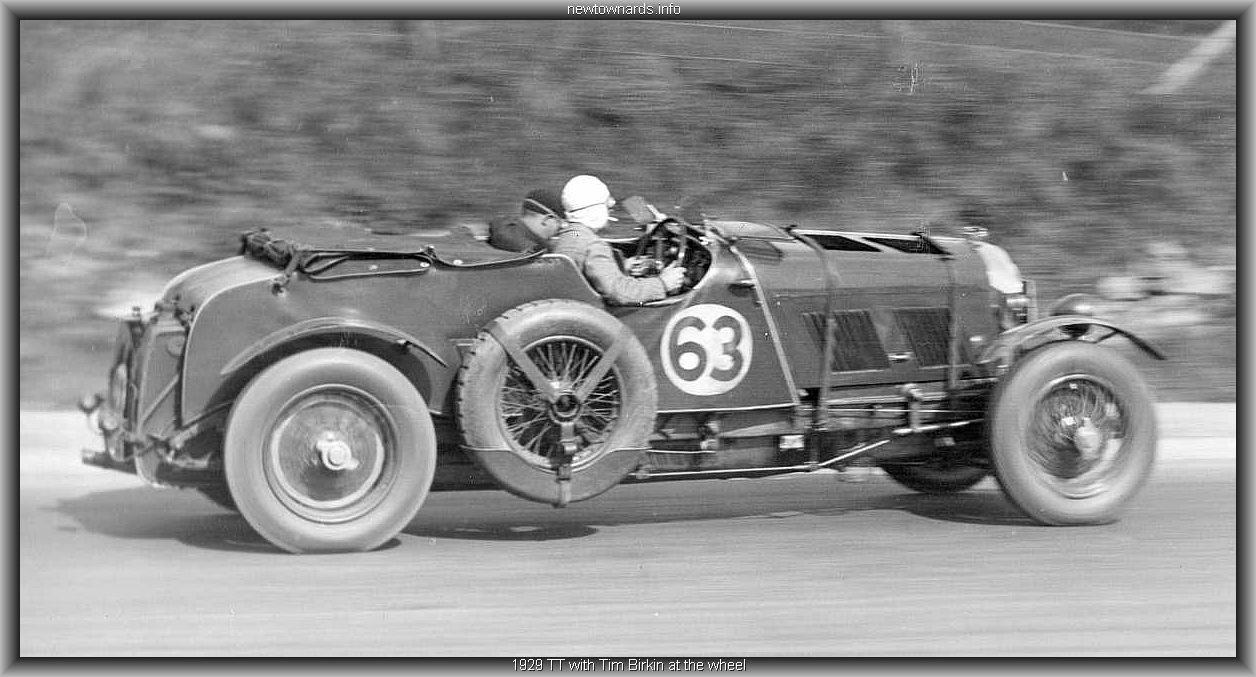
Many thanks to Michael McDowell for this high quality pic of Tim Birkin in the 1929 event.
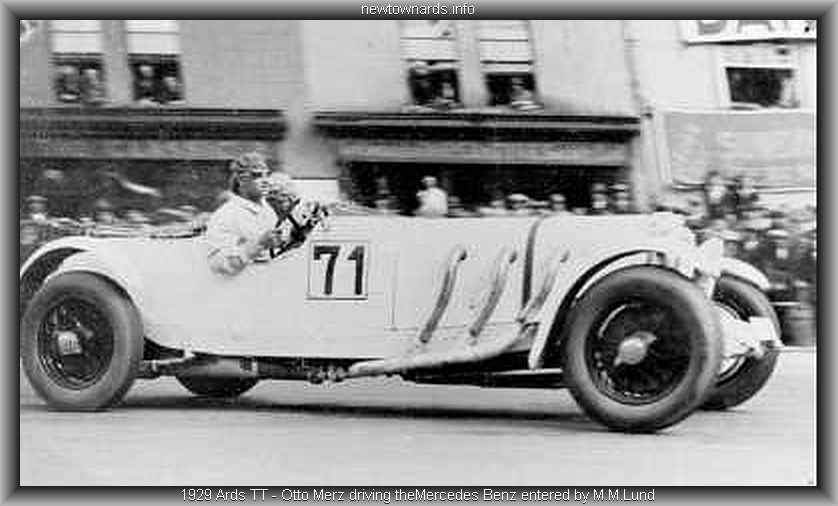
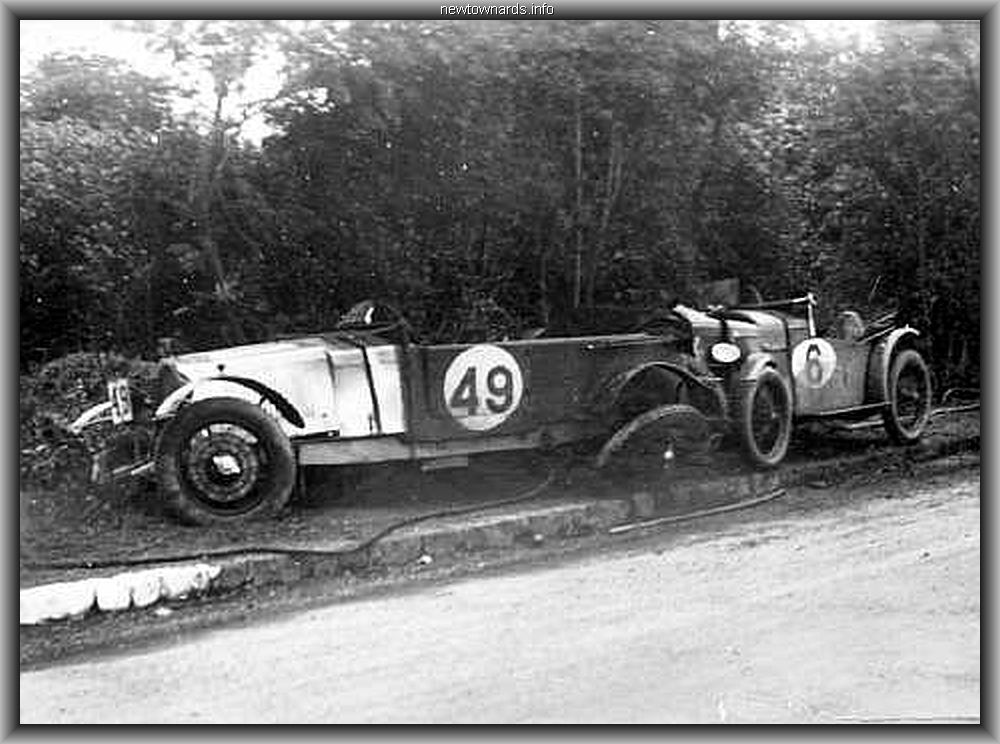
1929 TT. after an accident involving Fran Clark driving an OM when he
lost control at Ballystockart, as the marshalls were moving his car Grindlay
in a Triumph Super 7 swept into view and could not avoid the OM consequently
Clark and a marshall lost their life.
Results
1 - Rudolf "Rudi" Caracciola - Mercedes Benz SSK
Other Info so far ....
Eddie Hall - Crashed his Arrol-Aster Supercharged 17/50 into the
side of the townhall having failed to enter Conway Square
Otto Merz crashed but restarted only to be disqualified later.

Mr Beattie
I have just enjoyed your website, some superb photographs. My query? I have a few TT
cars but I am interested in the 1934 race at the moment. I
own race number 5, the Ford V8 entered by Stanley Wright. By any chance have you any
photos of this car or the other two Fords, numbers 4 and 6?
Hoping you may be able to help. Regards, SImon Thomas - Comber - Can anyone
out there help .... ?
![]()